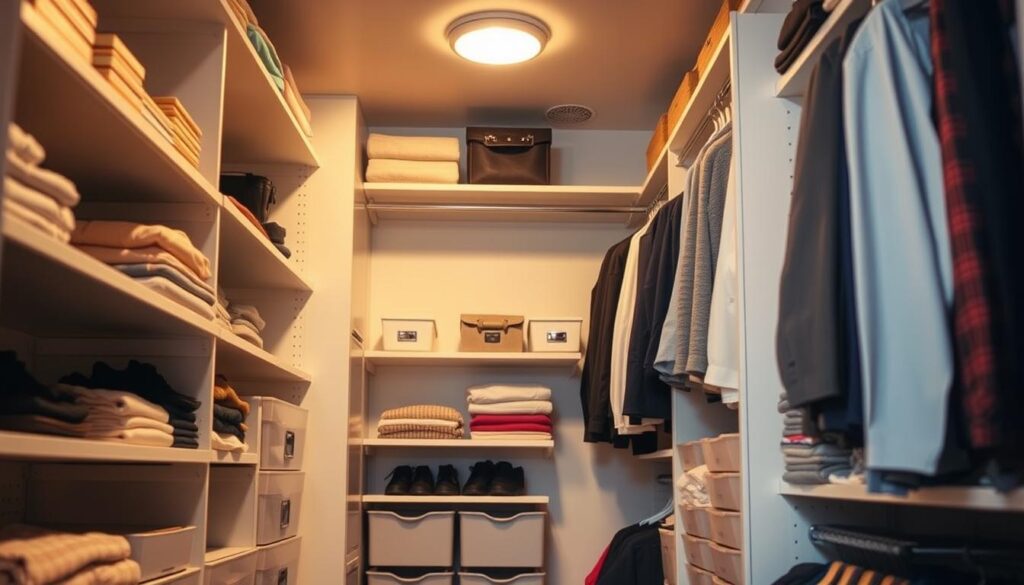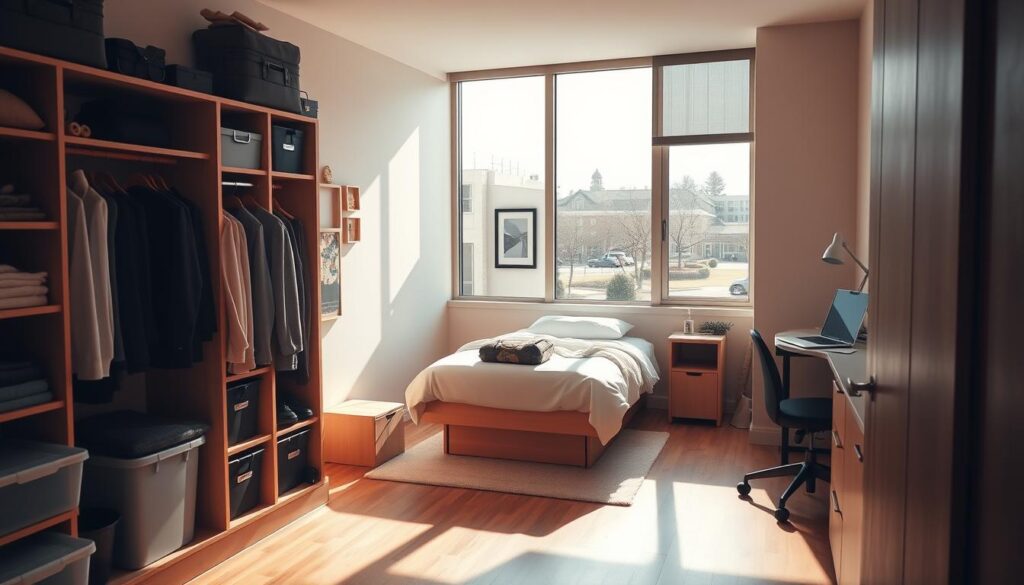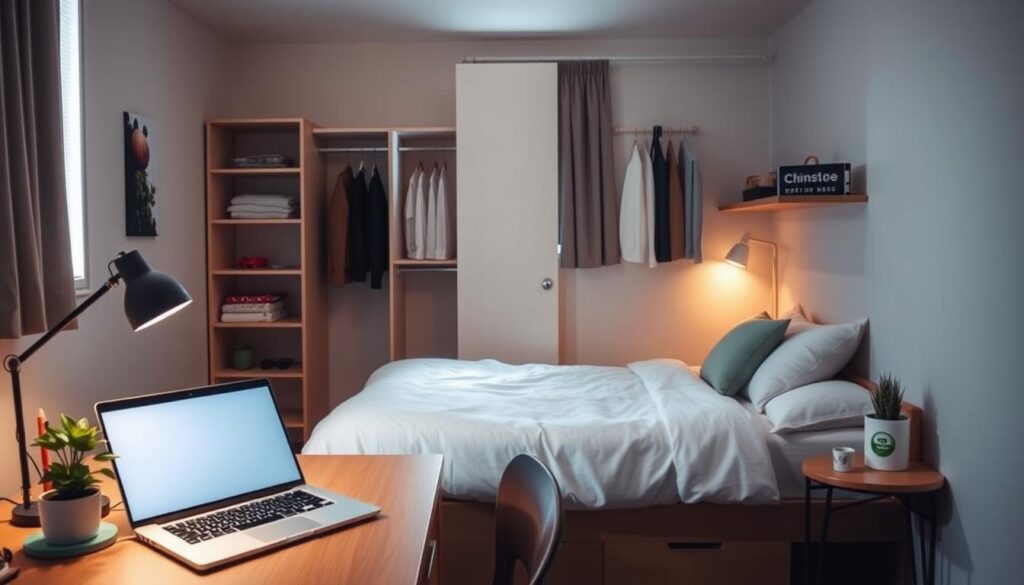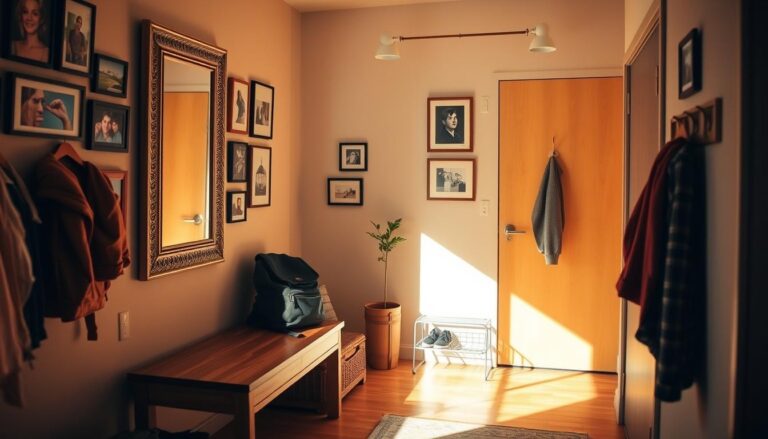How to Maximize Closet Space in Tiny Dorms
Maximize tiny dorm closet space with our expert guide to dorm closet organization. Discover top products for a clutter-free room.
Many college students find a single, small closet and a tiny dresser on move-in day. This limited space forces them to rethink how clothes and essentials live in one compact area.

The guide shows how smart storage and simple organizers can turn vertical and hidden areas into usable capacity. Hanging sweater shelves, multi-rod hangers, and over-the-door shoe holders multiply hanging room and carve out neat compartments.
Readers will learn to measure, prioritize what stays in the closet, and move seasonal items under the bed or to shelving. Planning with a short checklist saves time and money and ensures each piece fits the actual space.
This short resource maps product types to common pain points—shoes on the floor, sweaters slipping off hangers—and offers placement tips for move-in day. With modular picks, students can adapt their setup across semesters and keep a tidy life in a small room.
Key Takeaways
- Measure the closet before buying any storage pieces.
- Use vertical solutions to multiply hanging and folded space.
- Prioritize daily essentials in the closet; move seasonal items elsewhere.
- Choose modular organizers that adapt each semester.
- Match product types to common problems like shoe piles or slipping sweaters.
Why Dorm Closets Feel Smaller Than Home—and What That Means for Storage
What once spread across hallways and coat closets now competes for inches in one compact area. That shift explains why familiar wardrobes suddenly overwhelm available space.
From hallway closets to one pint-sized space: the college dorm reality
At home, winter coats, extra shoes, and laundry supplies live in multiple spots. In a campus room, those same items must find room inside a single hanging area or move under the bed.
What Else Would You Like to Know?
Choose below:
No hall storage and maybe a mini dresser: common constraints students face
Limited shelving and a small dresser change packing strategy. Bulky sweaters belong on vertical hanging shelves so the rod stays free for shirts and jackets.
- Floor shoe clutter becomes a trip hazard—use over-the-door or vertical racks to clear pathways.
- Map daily clothes, formal wear, workout gear, and outerwear to specific zones for faster mornings.
- Rotate seasonal items to under-bed bins to keep the main area functional.
Smart organizers turn empty vertical inches into neat compartments. This reduces morning friction and helps students keep campus life tidy. Later sections show which products best fit each constraint.
How to Choose Dorm Closet Organizers for a Tiny College Dorm
Before buying anything, measure height, rod depth, door swing, and shelf gaps so gear fits. A tape measure and a simple sketch save returns and mismatched purchases.
Measure first
Measure first: height, rod depth, door clearance, and shelf spacing
Check interior height, the distance from rod to floor, door clearance for over-door units, and fixed shelf gaps that can block hanging shelves. Note hanger depth so shirts and jackets hang without catching.

Prioritize essentials: clothes, shoes, and accessories that must fit
Rank items by use. Place daily clothes and shoes at eye and hand height. Store occasional outfits and bulky items on higher or lower shelves to free prime hanging space.
Modular picks that adapt to changing dorm room layouts
Choose adjustable hanging shelves, clip-on rod doublers, and stackable bins. Use fabric shelves for folded items and rigid cubes for heavy jeans. Add cascading and slim velvet hangers to increase capacity without bending the rod.
- Match organizer dimensions to door and rod limits; swap over-door racks for rod-hung vertical holders if the door rubs.
- Use clear, labeled bins for accessories and off-season items for easy rotation.
- Leave small air gaps and prefer breathable fabric pieces to reduce wrinkles and odors.
Final buying sequence: measure, map categories, pick pieces that fit, then test-fit during move-in. Check return windows and durability so replacements are simple if sizes don’t work.
Dorm Closet Organization: Best Products to Maximize Space
Smart products turn narrow hanging areas into high-capacity storage solutions. Students can reclaim vertical inches and door panels so the floor stays clear and mornings run smoother.
Hanging sweater shelves work well for folded shirts and jeans. Choose 5–8 shelf fabric units with reinforced bottoms. Leave rod width free for shirts and jackets and pick a length that clears the floor.
Over-the-door and vertical shoe holders clear floor clutter. Low-profile 24-pocket fabric or mesh panels close the door. For bulky sneakers, use wider pockets or a rod-hanging shoe tower so daily pairs sit at eye level.
- Multi-rod & cascading hangers: Add a rod doubler and cascading hangers to stack garments without crowding the rod.
- Under-bed & stackable bins: Store off-season coats and spare bedding in latching, low-height bins with side labels for quick swaps.
- Accessory solutions: Use slim belt hangers, scarf rings, small trays for jewelry, and a door-mounted hook rail for grab-and-go bags.
| Product | Best for | Material |
|---|---|---|
| Hanging sweater shelves | Folded clothes, tees, jeans | Breathable fabric with reinforced bottom |
| Over-door shoe panel | Daily shoes, flats | Mesh or fabric pockets |
| Rod-hanging shoe tower | Bulky sneakers, seasonal boots | Sturdy fabric, metal hook |
| Under-bed latching bin | Off-season items | Clear plastic for visibility |
| Multi-rod doubler | Double hanging capacity | Metal/plastic clamp |
Set Up Your Small Space: Smart Placement Tips for a Tidy Dorm Room
A fast, planned setup turns a cramped wardrobe into a calm, usable part of campus life.
Quick setup checklist: Start empty, wipe shelves and the rod, confirm measurements, and install core organizers first. Place hanging sweater shelves, rod doublers, and the door unit so every inch is claimed before clothes go back in.
Zone it, then load heavy-to-light
Center daily wear at eye height for fast mornings. Put specialty outfits to the sides and store least-used items high or low.
Load heavier items such as jeans and hoodies onto lower shelves or the bottom of a tower to stabilize the unit. Hang lighter tees and sleepwear higher. Place heavy coats on sturdy hangers toward the outer sides.

- Most-worn shoes go at hand height in the door panel or mid-tier of a hanging shoe tower; rotate seasonally into labeled under-bed bins.
- Mount a belt and tie hanger near the front; use a small tray for jewelry and tech essentials.
- Label cubbies and color-code hangers (tops, bottoms, outerwear) for fast resets after laundry day.
| Tip | Best for | Result |
|---|---|---|
| Start empty | Measure + install | Fewer returns, better fit |
| Zone by use | Daily vs. seasonal | Quicker mornings |
| Load heavy-to-light | Jeans, tees | Stable, tidy space |
Leave small gaps for airflow and schedule a five-minute weekly tidy. Keep a medium overflow bin for items not worn in two weeks. Choose fold-flat organizers and stackable bins for easy moves between semesters and long college life.
Conclusion
A compact hanging area becomes useful when students map the space, set zones, and choose targeted pieces.
Hanging sweater shelves, over-the-door or vertical shoe holders, multi-rod and cascading hangers, and under-bed bins form the core toolkit. These items expand usable room and keep daily clothes in reach.
They should prioritize essentials at eye level and rotate seasonal items out of the main area. A five-minute weekly reset keeps stacks tidy, hangers aligned, and outfits visible.
Modular, flexible organizers adapt across semesters. Apply the move-in checklist to optimize space right away and enjoy a calmer college life all year.
FAQ
How can a student maximize space in a tiny dorm closet?
Why do dorm closets feel smaller than at home?
What measurements are essential before buying closet organizers?
Which types of organizers work best for shoes and footwear?
How should a student prioritize what stays in the closet?
Are modular organizers worth the investment for a college room?
What are quick setup tips for a tidy small space?
Which accessory organizers are best for belts, scarves, and small items?
How can students store bulky sweaters without wasting space?
What should be considered when adding under-bed storage?
Transform Your Dorm Entryway with These 5 Smart Hacks
» See exclusive tips for your home








